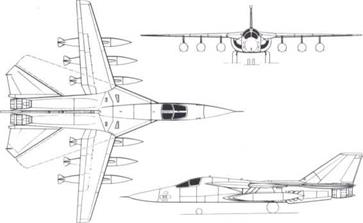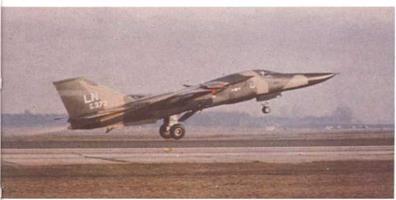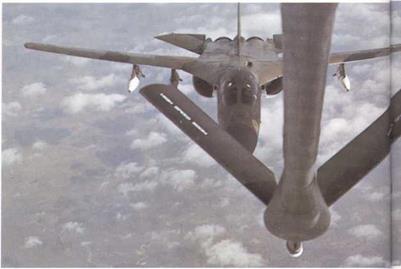General Dynamics F-111
"TFX ", F-111 A to F-111F, EF-111A and FB-111A
Origin: General Dynamics/Fort Worth (EF-111A, Grumman Aerospace), USA.
Type: Two-seat all-weather attack bomber: (EF) two-seat electronic warfare: (FB) two-seat strategic bomber.
Engines: Two Pratt & Whitney TF30 two-shaft afterburning turbofans, at following ratings: (F-111 A, C) TF30-3 at 18,5001b (8390kg): (D, E) TF30-9 at 19,6001b (8891 kg): (F) RF30-100 at 25,1001b (1 1,385kg): (FB) TF30-7 at 20,350lb (9230kg).
Dimensions: Span, 72-5° sweep (A, D, E, F) 31ft 11-yin (9-74m); (C, FB) 33ft 11 in (10-34m): span, 16° sweep (A, D, E. F) 63ft (19-2m); (C, FB) 70ft (21 -34m): length 73ft 6in (22 4m): height 17ft 1£in (5-22m). Weights: Empty (A, C) 46,1721b (20,943kg): (D, E, F) about 49,0001b (22,226kg): (FB) about 50,0001b (22,680kg): maximum loaded (A, 3) 91,5001b (41,500kg): (D, E, F) 99,000lb (44,906kg): (FB) 119,0001b (54,000kg).
Performance: Maximum speed (clean), Mach 2-2 at 35,000ft or above, or about 1,450mph (2335km/h): maximum speed at low level (clean) Mach 1 -2 or 800mph (1287km/h): maximum speed at maximum weight, subsonic at low level: service ceiling (clean) (A) 51,000ft (15,500m): (F) 60,000ft (18,290m): range on internal fuel (A, C) 3,1 65 miles (5093km). Armament: Internal bay for two 750lb (341kg) bombs or 20mm M-61 multi-barrel gun: eight underwing pylons for total of 31,5001b (14,290kg) of stores, inner pylons swivelling with wing sweep and outer four being fixed and loaded only with wing at 1 6°.
History: First flight 21 December 1 964: service delivery June 1967: first F-111 F with -100 engine, May 1973: EF-111A (Grumman ECM conversion) 1977.
Users: Australia, US Air Force. continued►
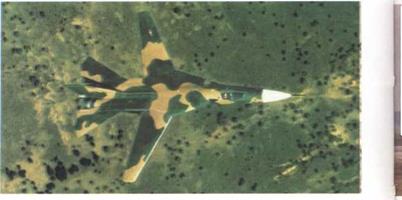 |
Below: An unusual view of an F-111 E, an interim version basically similar to the original F-111A but with enlarged engine inlet ducts (for a more powerful version of the TF30 afterburning turbofan which was never fitted). The main unit equipped with this sub – type is the 20th TFW based at RAF Upper Heyford, in England. Aircraft in normal operational service have a black radome, unlike that of this aircraft which was on test missions in the United States. Even today the F-111 is the only true all-weather tactical aircraft in service, apart from the US Navy A-6.
|
Above: Three-view of the FB-111A strategic bomber version. |
|
|
Above: A gaily-painted development prototype of the EF-111A all – weather electronic-warfare aircraft, with canoe (belly) and fin aerials for the ALQ-99 EW (Electronic Warfare) installation. The EF-111A programme is being handled chiefly by Grumman.
Below: Considerably more powerful than any other type of F-111, the F-111 F is an excellent aircraft in all respects. All the examples of this sub-type in combat duty are serving with the 48th Tactical Fighter Wing at RAF Lakenheath. England, where this photograph was taken in 1979 during training missions.
|
|
|
|
Development: Developed to meet a bold Department of Defense edict that a common type of "fighter" called TFX should be developed to meet all future tactical needs of all US services, the F-111A proved both a world – beater and a great disappointment. Thrown into the public eye by acrimonious disagreement over which bidder should get the production contract, it then stayed in the news through being grosslyoverweight, up in drag and suffering from severe problems with propulsion, structure and systems. Eventually almost superhuman efforts cleared the F-111A for service, overcoming part of the range deficiency by a considerable increase in internal fuel. The RAAF bought 24 F-111C with long-span wings and stronger landing gear and took delivery after they had been nine years in storage. The RAF ordered 50 similar to the C but with updated avionics, but this deal was cancelled. Only 141 low-powered А-models were built, the US Navy F-111 В fighter was cancelled, and the next batch was 94 of the E type with Improved intakes and engines (20th Tac Ftr Wing at Upper Fleyford, England). Then came the 96 F-111D with improved avionics (27th TFW in New Mexico) and finally the superb F-11’1 F with redesigned P-100 engine of greatly increased thrust and cheaper avionics (366 TFW, in Idaho). The heavier FB-111A, with the ability to carry six AGM-69A SRAM missiles externally, was bought to replace the ES-58 and early B-52 models in Strategic Air Command. Cost-inflation cut the FB order from 210 back to 76. With several RF and ECM conversions the total programme amounted to 539 plus 23 development prototypes. To keep the line open a further 12 were authorised in 1974 to be built at a low rate until 1976. 1
In 1979 the only work on F-111s was structural improvement of aircraft in service and Grumman’s conversion of surplus F-111 As to EF-111A standard with the ALO tac-jamming system of the EA-6B Prowler but without extra crew. Despite lack of funds it is hoped to rebuild 40 aircraft of this type to equip two USAF squadrons. The EF will not carry weapons, and will direct other aircraft. No aircraft has ever had worse luck or a worse press, and in combat in South East Asia the sudden loss of three of the first six aircraft was eventually found to be due to a faulty weld in the tailplane power unit. In fact all models of the F-111 are valuable machines with great range and endurance, excellent reliability and great ability to hit a point target in a first-pass strike, even in blind conditions. These aircraft are bombers, with much greater power and weight than four-engined bombers of World War II. It was unfortunate they were loosely launched as "fighters".
Left: Apart from the much older and probably more vulnerable B-52 the only American strategic bomber is the FB-111A, one of which is seen here about to take fuel from a KC-135 tanker. It is carrying its usual armament of four SRAM missiles on the external pylons; if necessary a further two can be accommodated in an internal bay plus two (rarely, four) more on additional wing pylons.
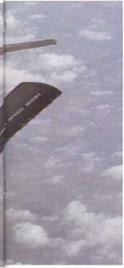
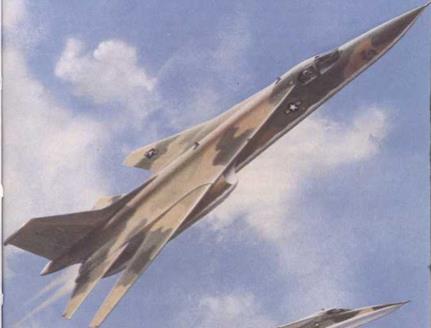
Below : Since the early 1970s General Dynamics has been proposing ‘stretched’ versions of the FB-111A as a new strategic bomber for USAF Strategic Air Command. This artist’s impression shows the FB-111 H, with longer fuselage, much greater fuel capacity, bogie main landing gears and two General Electric F101 engines (the same as used in the cancelled B-1 bomber). It would have been an extremely formidable aircraft with much greater radius of action than the somewhat limited FB-111A but was never built.











